Mercury (automobile)
.svg.png) | |
| Division | |
| Industry | Automotive |
| Fate | Defunct |
| Founded | 1938 |
| Defunct | January 4, 2011 |
| Headquarters | Dearborn, Michigan, U.S. |
Key people | Edsel Ford, founder |
| Products | Automobiles |
| Parent | Ford Motor Company |
| Website | www.MercuryVehicles.com |
Mercury is a defunct division of the American automobile manufacturer Ford Motor Company. Marketed as an entry-level premium brand for nearly its entire existence, Mercury was created in 1938 by Edsel Ford. Forming half of the Lincoln-Mercury Division, the brand was intended to bridge the price gap between the Ford and Lincoln vehicle lines. In a similar context, Buick and Oldsmobile played the same role within General Motors while the Chrysler Division did so within Chrysler Corporation (following the end of DeSoto and the creation of Imperial).
In 1939, the Mercury Eight was given a distinct body from Ford; from 1941 onward, to reduce development and production costs, Mercury vehicles shared commonality with either Ford or Lincoln (or both). To various extents, nearly all Mercury vehicles were rebadged. During the development of the Edsel division, its premium vehicles were developed in tandem with Mercury counterparts; following the closure of Edsel, Mercury vehicles were distinct from Ford and Lincoln.
In the summer of 2010, Ford Motor Company announced the discontinuation of the Mercury division as it consolidated its marketing and engineering efforts on the Ford and Lincoln brands. Production of Mercury vehicles ceased in the fourth quarter of 2010.[1][2] At the time, Ford sold Mercury vehicles in the United States, Canada, Mexico, Puerto Rico, U.S. Virgin Islands, and the Middle East.
The final Mercury automobile, a 2011 Mercury Grand Marquis, rolled off the assembly line on January 4, 2011.[3] Although the final vehicle of the division was produced in 2011, Mercury remains an active and registered trademark owned by Ford Motor Company (to at least 2025).[4]
History
During the mid-1930s, despite the continuing success of its new V8-powered product line, Ford Motor Company was again in danger of being left at a competitive disadvantage to both of its largest competitors. While General Motors and upstart Chrysler Corporation both offered a comprehensive line of brands (in terms of price), by 1935, Ford remained with its namesake brand and the cars of Lincoln Motor Company. Aside from the Cadillac V-16, the Packard Eight and Duesenberg Model J, the Lincoln Model K was one of the most expensive vehicles built and sold in the United States.
As a solution, in 1936, Ford launched its own version of the 1920s General Motors Companion Make Program. As its first effort to bridge the massive price gap between the standard V8 Ford and the V12 Lincoln Model K, the Lincoln-Zephyr was introduced in 1936 as a competitor for the similar LaSalle, Chrysler Airstream, and Packard One-Twenty. Within a single year, the new model proved successful, with over 15,000 Lincoln-Zephyrs sold.
Inside Ford Motor Company, there remained debate whether a medium-price car should be produced under the Ford brand or under a new marque entirely. Following the success of the Lincoln-Zephyr, the company would take both approaches. For 1938, the De Luxe Ford model line was introduced as a higher-price version of the standard Ford V8. To differentiate the two model lines, the De Luxe Ford was given its own trim, a different hood, and a model-specific grille.
To offer a medium-price car under its own marque, Edsel Ford began Mercury as a separate company within Ford in 1937. Though used on the Chevrolet Mercury for 1933, the Mercury name was selected from over 100 potential model and marque names.[5][6] In place of a slight restyling, as seen on the De Luxe Ford, the Mercury was an all-new car, with the body design overseen by E.T. 'Bob' Gregorie.
1939-1940s
For the 1939 model year, the Mercury made its debut with a namesake vehicle line. An all-new car, sharing no body panels with any Ford or Lincoln, the Mercury was six inches wider than the 1939 Ford with a 116-inch wheelbase (four inches longer). To minimize production costs, in place of developing a division-specific engine, the Mercury was offered with a 95hp Ford Flathead V8, expanded to 239 cubic inches. Over 65,800 1939 Mercury cars were sold, at a starting price of $916 (approximately $16,090 in 2016 dollars).[7][8]
For 1941, the Mercury underwent its first redesign; on an official basis, the model line adopted the Mercury Eight nameplate used in sales literature. In what would be become tradition with succeeding Mercury model lines, the Mercury Eight shared much of its bodyshell with the Ford V8. To distinguish the two marques, along with its 4-inch longer wheelbase, the Mercury Eight has a model-specific grille, exterior trim, and taillamps.
For the shortened 1942 model year, only 1,902 Mercury vehicles were produced. Before production ended, several major changes were introduced. For the first time, the Flathead V8 was offered with 100hp in standard form. As part of an interior redesign, the Eight received a dashboard configured similar to the Lincoln Zephyr. The 1942 Mercury Eight marked the first appearance of a semi-automatic transmission ("Liquimatic") by Ford Motor Company; along with the shortened model year, the option proved unpopular.
Following the end of World War II, in 1945, Ford merged Mercury and Lincoln Motor Company into a combined Lincoln-Mercury Division; while functioning as a single division of Ford, the two brands would continue to market their namesake model lines. As a result of the popularity of Mercury, the De Luxe Ford was phased out as a sub-brand in 1940, with the use of the name ended entirely during the introduction of the 1949 Ford line. Although Lincoln removed the Zephyr name from its line after the war, the car itself continued on as a Lincoln through 1948, alongside the Lincoln Continental.
For 1946, the Mercury Eight returned to production. Although functionally unchanged, the 1946 Mercury was distinguished from its Ford counterpart by a vertically-oriented grille. Through 1947 and 1948, few major changes were made.
For 1949, Ford Motor Company launched its first post-war model lines for all three of its model lines. To gain exposure for both Lincoln-Mercury brands, the Lincoln was given the same bodyshell as the 1949 Mercury Eight, largely distinguished by headlight and grille designs; Mercury and Lincoln would feature separately-trimmed interiors. Mechanically, each brand offered its own version of the Ford Flathead V8.
For many years after its production, the 1949-1951 Mercury Eight (most commonly in two-door form) would develop a following as a street rod, making an appearance in several films.
.jpg) 1939 Mercury Model 99A
1939 Mercury Model 99A 1941 Mercury Eight coupe
1941 Mercury Eight coupe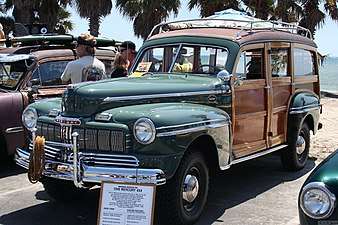 1946 Mercury station wagon (Marmon-Herrington 4x4 conversion)
1946 Mercury station wagon (Marmon-Herrington 4x4 conversion)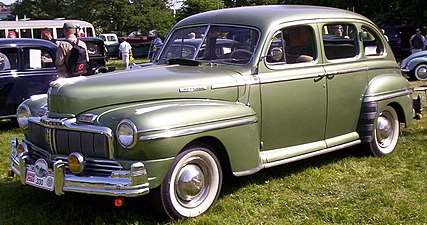 1947 Mercury Town Sedan
1947 Mercury Town Sedan- 1949 Mercury Eight sedan
1950s
In contrast to the medium-price brands of Chrysler and General Motors, whose brands sold a range of nameplates, the Mercury division of Ford consisted solely of the Mercury Eight in 1950. To make itself more competitive, as the Mercury Eight was redesigned for 1952, Mercury reintroduced the car as two vehicles: the Mercury Custom and the higher-priced Mercury Monterey. Still sharing most its bodyshell with Lincoln, the Monterey/Custom used a higher-output Ford V8 engine. For 1954, the long-running Flathead V8 (from 1932) was replaced by an overhead-valve Y-Block V8.
Early in the 1950s for the 1951 model year, Mercury got an automatic transmission, called the "Merc-O-Matic" drive.[9]
During the mid-1950s, the use of a common bodyshell between Lincoln and Mercury divisions continued. Above the Monterey, the Mercury Montclair was introduced in 1955 (aside the Ford Fairlane). To avoid confusion with the Ford Custom, the base-trim Mercury Custom was renamed the Mercury Medalist for 1956.
During the late 1950s, the launch of the Edsel brand would significantly affect both the Lincoln and Mercury divisions. For 1957, the entire Mercury product line was redesigned; for the first time since 1948, Mercury vehicles no longer shared a common body with Lincoln. While the Medalist was discontinued, Mercury gained a flagship in the Mercury Turnpike Cruiser (the pace car of the 1957 Indianapolis 500). In line with Ford, Mercury introduced station wagons as a stand-alone model line for 1957: Commuter, Voyager, and woodgrained Colony Park. While Lincolns would shift to unibody construction for 1958, the 1957 Mercury line shared the chassis and underpinnings of the premium models of the upcoming Edsel range. In a marketing decision that would prove fatal to the future of the Edsel brand, the pricing of the Edsel division overlapped the Mercury division completely. For 1958, the role of the Turnpike Cruiser gradually was overtaken by the Mercury Park Lane, replacing it entirely for 1959.
As the largest vehicles in the new Mercury lineup had a curb weight approaching 5,000 lb (2,300 kg), Ford introduced its first big-block V8. A retuned version of an engine shared with Lincoln, the 430 cubic-inch Super Marauder V8 was the first production engine sold with an advertised 400 hp output. Following the discontinuation of the premium Edsel Corsair and Citation, for 1959, Mercury produced a body and chassis unique to the division (sharing its V8 engine with Lincoln). As with their unibody Lincoln counterparts, the 1959-1960 Mercurys are the longest-wheelbase and heaviest vehicles produced with the exception of the 1973-1978 model lines.
.jpg) 1950 Mercury Eight 4-door
1950 Mercury Eight 4-door.jpg) 1952 Mercury Monterey convertible
1952 Mercury Monterey convertible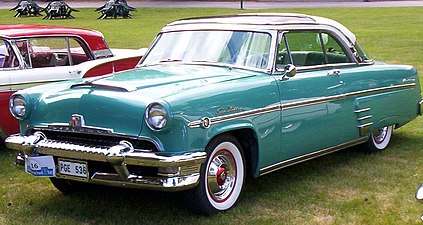 1954 Mercury Monterey Sun Valley (Ford Crestline Skyliner)
1954 Mercury Monterey Sun Valley (Ford Crestline Skyliner).jpg) 1956 Mercury Montclair 4-door hardtop
1956 Mercury Montclair 4-door hardtop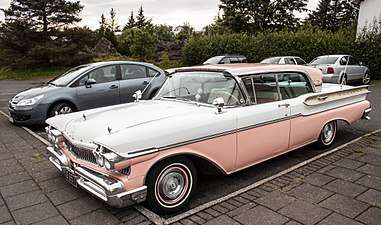 1957 Mercury Turnpike Cruiser 4-door hardtop
1957 Mercury Turnpike Cruiser 4-door hardtop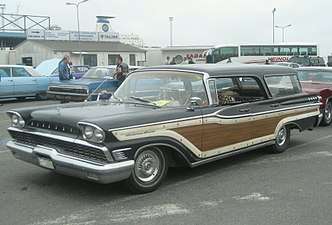 1959 Mercury Colony Park
1959 Mercury Colony Park
1960s
The economic recession of the late 1950s hit all mid-priced car lines of American manufacturers. Coupled with the recession, the heavily marketed Edsel division overlapped Mercury completely in price; the adoption of unibody construction by Lincoln proved expensive to produce. Several Ford executives, led by Ford President Robert McNamara proposed ending the losses by streamlining Ford Motor Company down to its namesake division. By the end of 1959, the Edsel division was discontinued.
After McNamara joined the Kennedy administration to become Secretary of Defense, Lincoln-Mercury gained a reprieve, with major changes made to the model lines. The Continental became the sole model for Lincoln, much smaller than its predecessor. For Mercury, the division expanded into several model segments while returning to its roots based on the full-size Ford for 1961.
For 1960 (a year before Buick, Oldsmobile, and Pontiac), Mercury introduced its first compact car, the Mercury Comet. A Ford Falcon with its wheelbase stretched to 114 inches, the Comet was sold with a 90-hp inline-six (becoming the first Mercury ever sold without a V8 engine). Originally developed to become the entry-level vehicle of the Edsel line, the Comet was sold without divisional badging until 1962 (similar to the original Valiant from Plymouth).
When the full-size Mercury sedan line switched from the Mercury/Edsel platform to a Ford platform for 1961, the sedan line was trimmed to the Monterey. A second full-size car was added, the Mercury Meteor, priced between the Comet and Monterey. As with the Comet, the Meteor was a stillborn Edsel model put in production as a Mercury; effectively, the 1961 Meteor was the last Edsel.
For 1962, Mercury re-organized its model line to be closer to that of Ford. As Ford introduced the Ford Fairlane, Mercury shifted the Meteor into the intermediate segment and reintroduced it as the counterpart of the Fairlane. The division also started remarketing an image of high performance features in all of its models, with "S" sub-models of all three Mercury vehicles. The S-22 (Comet), S-33 (Meteor), and S-55 (Monterey) all featured high-performance powertrains along with full-length consoles and bucket seats.
For buyers seeking to distinguish their Monterey from others, in 1963, Mercury offered two different rooflines as an option to the standard sedan. The "breezeway" reverse-slant rear window was similar to the Turnpike Cruiser and 1958–1960 Lincolns. Somewhat more sporting was the fastback "Marauder" hardtop roofline; while it was also a design shared with Ford, its aerodynamics helped Mercury gain ground in stock-car racing.
By the middle of the decade, the division had secured its future. No longer entangled with the failure of the Edsel brand, Mercury competed closely against Buick, Oldsmobile, the middle of the Chrysler range, and the top of American Motors range. While the 1965 full-size Mercury range still were essentially long-wheelbase variants of the Ford Galaxie, the division underwent many steps to better differentiate a Mercury from a Ford. Adopting the straight-lined styling similar to Lincoln, the cars were marketed as "built in the Lincoln tradition". To distance itself from the Ford Falcon, the Comet took the place of the Fairlane-based Meteor in 1966, growing into the intermediate segment.
For 1967, Mercury introduced two of its most successful nameplates. Intended to bridge the gap in price, performance, and luxury between the Ford Mustang and the Ford Thunderbird, the Mercury Cougar was a restyled version of the Mustang with a greater emphasis on comfort and equipment. The Cougar would remain in production for 34 years, the second-longest production run of any Mercury. Following the positive reception of the Ford LTD, Mercury introduced the Mercury Marquis as a two-door hardtop version of the Park Lane Brougham. Competing against the Chrysler New Yorker, the Oldsmobile Ninety Eight, and Buick Electra, the Marquis nameplate (in various forms) would survive until the final Mercury vehicle was produced in 2011.
For 1968, the intermediate line was expanded, as the Mercury Montego was introduced, based on the Ford Torino. Largely the replacement for the Comet, it was marketed as a higher-trim vehicle, a marketing campaign that would be used several times in the next decade.
Along with producing cars competing for comfort, by the end of the decade, Mercury sought to preserve its high-performance image as well. For 1969, the Marauder became a stand-alone model replacing the S-55. While heavily based on the two-door Marquis, it wore its own bodywork from the windshield back. A personal-luxury coupe sized above the Ford Thunderbird, the Marauder was aimed at the Oldsmobile Toronado and Buick Riviera.
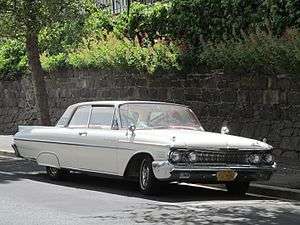 1961 Mercury Meteor 2-door hardtop
1961 Mercury Meteor 2-door hardtop.jpg) 1962 Mercury Comet 4-door sedan
1962 Mercury Comet 4-door sedan.jpg) 1964 Mercury Monterey Marauder
1964 Mercury Monterey Marauder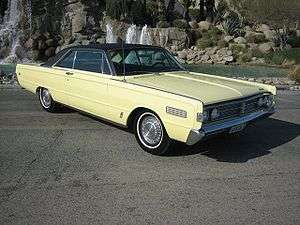 1966 Mercury S-55
1966 Mercury S-55.jpg) 1967 Mercury Cougar
1967 Mercury Cougar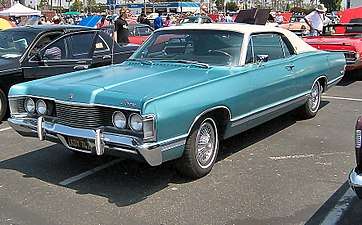 1968 Mercury Marquis
1968 Mercury Marquis.jpg) 1969 Mercury Montego
1969 Mercury Montego
1970s
During the 1970s, the product line of the Mercury division was influenced by a number of factors that affected all American nameplates. While sporty cars would not disappear from the division, Mercury refocused itself further on building high-content vehicles.
For the 1969 model year, the full-size Mercury line was given a redesign on an all-new chassis. Additionally, the Mercury line was consolidated, as the expanded Marquis line took the place of the Park Lane and Montclair lines (the Marauder coupe and Colony Park wagon nameplates were based on the Marquis), leaving the Monterey as the only other full-size nameplate. Differentiated from their Ford LTD counterparts primarily by their longer wheelbase (except for station wagons), Marquis-based models were also distinguished by hidden headlights.
On the other end of the size spectrum, Mercury entered the subcompact segment in 1970. In place of selling its own version of the Ford Pinto, the division turned to Ford of Europe, selling the Capri (European Ford Capri) as a captive import from Cologne, Germany. Slightly larger than the Ford Pinto, the Capri was marketed as a compact sports car rather than an economy car, becoming the first Ford Motor Company car in North America sold with a V6 engine. North American Capris did not have Lincoln or Mercury marque identification although the Mercury division handled Capri sales.
For 1971, the Marauder variant of the Marquis was discontinued and the Cougar was redesigned. To distance itself from the Mustang it was based on, the Cougar was now marketed against the A-body coupes (Chevrolet Monte Carlo, Oldsmobile Cutlass Supreme, Pontiac Grand Prix) from General Motors. The Comet made its return; now a compact car based on the Ford Maverick, it shared much of its chassis underpinnings with the original Comet from 1960.
In 1972, the intermediate Montego line (based on the Ford Gran Torino) was redesigned with a body-on-frame chassis; as part of the redesign, its dimensions grew, creeping into full-size territory.
In addition to the fuel crisis, 1973 saw major change to the Mercury line. In various forms, all Mercury cars were given 5-mph bumpers. The full-size line was given a major restyling; while Ford (and later Lincoln) 2-doors would be given B-pillars, all two-door Mercurys would remain true hardtops.
In the middle of the decade, the division made several changes that moved the division further into the "near-luxury" segment, a well-timed decision due to the collapse of the performance-car segment.
For 1974, the Cougar was split from the Mustang, becoming one of the last cars to be enlarged significantly. Most of the growth was due to its shift to the Montego chassis, the Cougar now became a twin to the Ford Elite styled as a smaller version of the Ford Thunderbird.
For the first time, Canadian Mercury dealers marketed a rebadged version of the Ford Pinto called the Bobcat offered in all of the same body styles and trim levels as the Pinto.
1975 marked several changes across the Mercury line. The long-running Monterey was discontinued, with the Marquis becoming the sole model; a new Grand Marquis was slotted between the Marquis and Lincoln Continental. Originally intended as the replacement for the Comet, the Monarch (essentially a rebodied version of the Comet), led to a completely new market segment: the luxury compact car. The Monarch was met with success; high-trim versions were popular choices as personal cars among Ford executives, including Henry Ford II.
U.S. Mercury dealers began selling the Bobcat with little success. The Capri became the second most popular imported car in the United States, only behind the Volkswagen Beetle; it was redesigned with a hatchback and rebranded Capri II for 1976.
For 1977, as it was one of its slowest-selling product lines, the Montego line (in its entirety) was replaced by the Cougar, with minor cosmetic updates. Previously a personal luxury coupe, the Cougar was now available in sedan and station wagon bodystyles (the latter for 1977 only) and was the twin of the Ford LTD II. The move proved successful, as Cougar sales nearly tripled.
In 1978, Mercury sales peaked at an all-time high of 580,000; nearly four out of ten 1978 Mercurys were Cougars. In addition, a transition began in the model lineup. Originally scheduled to be replaced by the Monarch in 1975, the Comet was replaced by the Zephyr (based on the Ford Fairmont). Derived from the all-new Fox platform, the rear-wheel drive chassis would serve as the basis for a number of compact and mid-size Ford, and Lincoln-Mercury cars from the late 1970s into the early 2000s.
For 1979, the first variant of the Zephyr would enter production as the Capri made its return. A clone of the all-new Ford Mustang, it would be sold through the 1986 model year.
At the end of the 1970s, as with many other American luxury-segment nameplates, the future of the Mercury division was threatened by the fuel crises of 1973 and 1979. As with the muscle car, the era of the landyacht was in its own decline.
 1972 Mercury Montego GT
1972 Mercury Montego GT- 1973 Mercury Comet
- 1975 Mercury Grand Monarch Ghia
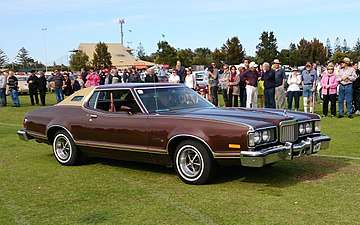 1975-1976 Mercury Cougar XR-7
1975-1976 Mercury Cougar XR-7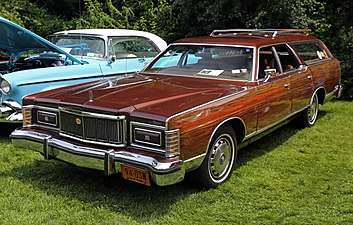 1978 Mercury (Marquis) Colony Park
1978 Mercury (Marquis) Colony Park.jpg) 1978 Mercury Bobcat
1978 Mercury Bobcat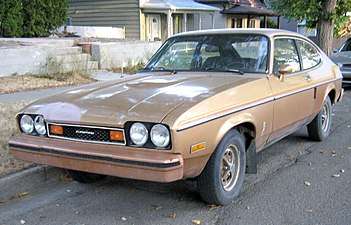 1976-1978 Capri II
1976-1978 Capri II
1980s
At the beginning of the 1980s, both in the interest of fuel economy and to modernize its model line, Mercury would redesign its entire model line between 1979 and 1982. Although downsized two years after its General Motors competitors, the 1979 Marquis/Colony Park would see significant marketplace success. Externally smaller than the Cougar, the new full-size Mercury line offered increased interior space over its predecessor along with extensive fuel economy gains; rear-wheel drive and a V8 engine remained standard. The Marquis externally differed from the LTD with its front end styling and horizontal tail lamp arrangement.
For the 1980 model year, the Cougar XR7 was downsized onto the Fox platform as a coupe only and remained a counterpart to the Ford Thunderbird. For 1981, Cougar nameplates were also applied to premium variants of the Zephyr to replace the discontinued Monarch. This round of downsizing for all Cougar models was disastrous due to controversial styling and lack of differentiation with other Fox-platform nameplates. Sales of the previously best-selling Mercury would collapse to one-third of 1979 levels.
The Bobcat was quietly replaced for 1981 by the Mercury Lynx, a clone of the Ford Escort. The first front-wheel drive Mercury, the Lynx, also offered the first diesel engine in a Mercury (as an option). The Ford EXP was sold from 1982 to 1983 as the Mercury LN7, the only two-seat vehicle sold by the division.
For 1983, a major model shift took place within all three Ford divisions as part of a model update and consolidation. For Mercury, to combat falling sales, the Cougar was given an all-new aerodynamic body; more significantly, it reverted to its role of a two-door coupe (a clone of the Thunderbird). The Cougar four-door and wagon were restyled and re-branded as the Marquis. For 1980, the full-size Mercury model line was now the Grand Marquis, a slightly upscale version of the Ford LTD Crown Victoria that was introduced the same year. In 1984, front-wheel drive made its appearance in compact-size Mercurys as the Topaz replaced the Zephyr; alongside its Ford Tempo clone, the Topaz was the first Mercury to offer a driver's-side airbag. While first introduced in the 1983 Cougar, the Topaz further advanced the aerodynamic, streamlined body soon to become commonplace throughout Ford Motor Company.
In late 1985, Mercury introduced the Mercury Sable alongside the Ford Taurus for 1986. Replacing the Marquis as the division's mid-size sedan and wagon, the design of the Sable sedan led it to be one of the most aerodynamic cars in the world at the time. Originally intended to be replaced by the Sable, stability in gas prices and demand for full-size car sales led to the continuation of the Grand Marquis and Colony Park. With the introduction of the Sable, Mercury began to introduce a styling feature that spread across many of its models for the next decade. The signature feature would be the (non-functional) lightbar grille; on all models, serif or script lettering would be replaced by chrome block lettering not seen on Fords.
For 1988, the Lynx was replaced by the Mercury Tracer, a version of the Ford Laser designed by Mazda, with US models being imported from Mexico and Japan, and Canadian models being imported from Taiwan.[10] Available as three- and five-door hatchbacks and a five-door station wagon, the Tracer was the first Mercury since the 1978 Capri II with no US-market Ford equivalent.
.jpg) Mercury Capri (1979-1982)
Mercury Capri (1979-1982) 1982 Mercury Lynx
1982 Mercury Lynx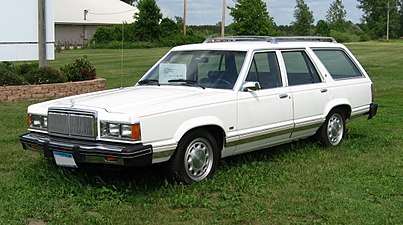 1982 Mercury Cougar GS
1982 Mercury Cougar GS 1983-1987 Mercury Grand Marquis
1983-1987 Mercury Grand Marquis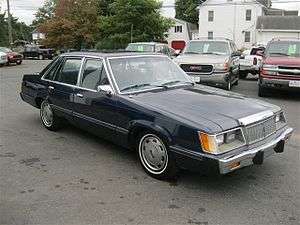 1985 Mercury Marquis
1985 Mercury Marquis 1987 Mercury Topaz
1987 Mercury Topaz 1989 Mercury Sable
1989 Mercury Sable
Merkur
Beginning in 1985, Ford experimented with importing two European Fords under the Merkur (the German word for Mercury, pronounced mare-coor) nameplate. The Merkur lineup consisted of the Merkur XR4Ti (a federalized version of the Ford Sierra) and the Merkur Scorpio (a rebadged version of Ford Scorpio). Merkurs were sold at participating Lincoln-Mercury dealerships throughout the United States and Canada. This approach was meant to revisit the success Ford had importing the European Ford Capri to North America during the 1970s.
After 1989, the brand was discontinued due to a combination of low sales and impending passive restraint regulations. Another key factor behind the demise of Merkur was an unfavorable exchange rate between the United States and West Germany; at US$25,000 (approximately $49,356 in current dollars), the Scorpio had a much higher base price than a Grand Marquis yet bore a closer resemblance to the Sable.
- Merkur XR4Ti
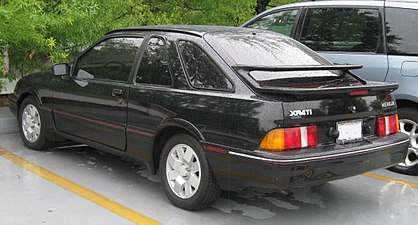 rear view of Merkur XR4Ti, showing biplane spoiler
rear view of Merkur XR4Ti, showing biplane spoiler.jpg) Merkur Scorpio
Merkur Scorpio.jpg) rear view of Merkur Scorpio
rear view of Merkur Scorpio
1990s
As Ford ended the Merkur division in 1989, the Mercury division itself began a major transition during the 1990s. As distinguishing itself from counterpart Ford (and Lincoln) models was a key factor, renewing the model line was imperative. In 1989, the first completely new Cougar since 1980 was introduced. While again a personal-luxury coupe based upon the Ford Thunderbird, the all-new platform allowed for major improvements to interior room and handling.
In 1991, Mercury gained a model unique to the division as it revived the Capri name for a second time as an import from Ford of Australia. Envisioned as a competitor to the Mazda MX-5, the Capri was a four-seat convertible with a front-wheel drive layout. Although neither car was related to each other, both the Capri and the MX-5 used a number of Mazda 323 components. After a two-year hiatus, the Tracer made its return to the Mercury line. Now a clone of the Ford Escort, both cars were near-twins of the Mazda Protegé; unlike the Escort, only a 4-door sedan and station wagon were available. With only detail changes since 1979, the Colony Park station wagon was discontinued at the end of the model year; only 3,104 1991 models were produced as buyers had shifted towards minivans, full-size vans, and large SUVs to use as family vehicles.
For 1992, the best-selling (and oldest) models of the model lineup saw major updates. The Sable was given an exterior and interior facelift; while its aerodynamic shape remained familiar, only the doors and roof were carried over from the 1991 model. The Grand Marquis, nearly unchanged since 1979, was given an extensive redesign inside and out. While still sharing its basic chassis from before, no sheetmetal was carried over; an all-new overhead cam V8 engine was the first of its kind in an American full-size car. While still far more aerodynamic than its predecessor, the more conservative styling of the Grand Marquis helped win buyers over the more radical Chevrolet Caprice (and Ford's own Crown Victoria); sales doubled from 1991 to 1992 to become the division's best-selling model through much of the 1990s.
Mercury sales rebounded in 1993 to over 480,000, their highest level since the 1978 all-time high. In the mid-1990s the brand received some free advertising when country music star Alan Jackson scored a hit with a 1993 cover of K. C. Douglas' "Mercury Blues", a song which heaped praise on their vehicles. Ford later used a different version of the song in its truck advertising.[11] It was also this year that television star Kate Jackson came on board as a regional spokeswoman for the Lincoln-Mercury sales division, promoting the Mercury models through the 1997 model year. In 1993, the division would make up for the loss of the slow-selling Colony Park station wagon by the introduction of the Villager. A nameplate originally seen on many Mercury station wagons during the 1960s and 1970s, the Villager was jointly developed with Nissan (whose version was called the Quest). A front-wheel drive minivan assembled in the United States, the Villager was chosen over a version of the Aerostar, which Ford marketed as part of its light-truck line. In terms of size, the Villager was sized in between both sizes of the Chrysler minivans and marketed as a competitor to the luxury Chrysler Town & Country.
The middle of the decade saw some controversial moves from the division. For 1995, the dated Topaz was replaced by the Mystique. While the Ford Mondeo "world car" it was based upon was considered a mid-size car outside of North America, in the United States and Canada, the Mystique/Ford Contour were criticized for being some of the least roomy cars compared to their competition. In 1996, the Sable was given a controversial redesign. While the sedan was largely differentiated from its Taurus counterpart, it was not well received by buyers; sales of the Sable fell by nearly one-third from 1996 to 2000. In a less radical redesign than the Sable, the sedan version of the Tracer was redesigned alongside the Escort for 1997; unlike the Sable, the Tracer only differed from the Escort in its grille design.
As the 1990s progressed, the division further explored the use of family vehicles. While it would follow both the Oldsmobile Bravada and the Acura SLX, the 1997 introduction of the Mercury Mountaineer would begin to popularize the mid-size luxury SUV segment. Based on the Ford Explorer, the Mountaineer differed from its Ford counterpart in the fitment of all-wheel drive in place of four-wheel drive and a V8 engine was standard (initially). The Mountaineer is also notable for introducing the silver "waterfall grille", which became a common styling theme on virtually all succeeding Mercurys. In 1999, the Villager underwent a redesign alongside the Nissan Quest; a driver's-side sliding door was added, as the lack of one had become a major sales obstacle following the 1996 redesign of the Chrysler minivans which included one.
By the end of the decade, the division began to slim its model lineup. After the 1997 model year, the Cougar was discontinued as the personal-luxury coupe market began to decline in demand. After 1999, the Tracer was discontinued; the Mystique was removed from production early in the 2000 model year.
 1989-1990 Mercury Cougar XR7
1989-1990 Mercury Cougar XR7.jpg) 1991-1993 Mercury Capri
1991-1993 Mercury Capri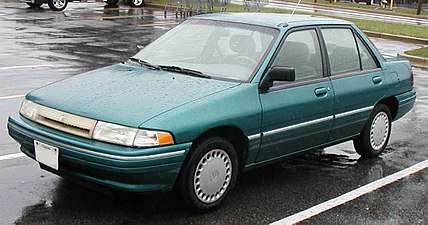 1992-1996 Mercury Tracer
1992-1996 Mercury Tracer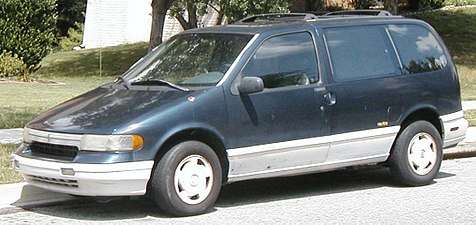 1992-1994 Mercury Villager Nautica
1992-1994 Mercury Villager Nautica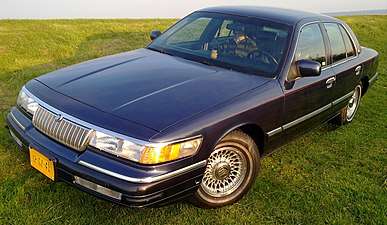 1994 Mercury Grand Marquis LS
1994 Mercury Grand Marquis LS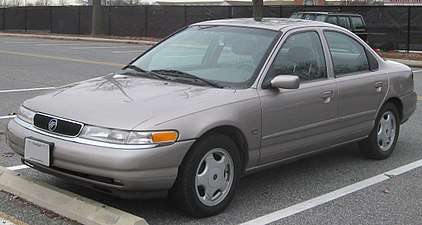 Mercury Mystique
Mercury Mystique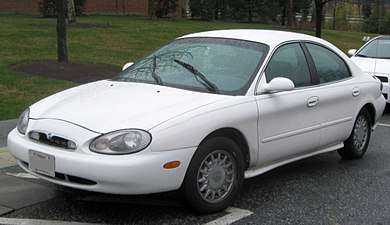 1996-1997 Mercury Sable
1996-1997 Mercury Sable- Mercury Mountaineer
2000–2011
By the beginning of the 2000s, the Mercury division began to struggle in efforts to modernize its brand image. While sales of the Grand Marquis (then the best-selling Mercury vehicle) were highly profitable, the mid-60s age of a Grand Marquis buyer was nearly two decades higher than what Lincoln-Mercury dealers sought to attract into showrooms.[12][13] During the 2000s, in multiple efforts to attract younger buyers to the brand, Mercury made a number of product changes and replacements. While the Mercury Grand Marquis and Sable retained market share at the beginning of the decade, the division effectively withdrew from compact sedans, discontinuing the Tracer in 1999 (three years before the Ford Escort) and the Mystique late in the same year.
At the beginning of the 2000s, Mercury began to shift from an identity of luxury towards performance. Initially discontinued after 1997, the Mercury Cougar was reintroduced for 1999. Beginning life as the third-generation Ford Probe, the first-ever front-wheel drive Cougar was based on the Mystique; as it was designed as a Ford Probe, the Cougar exited the personal luxury coupe segment, becoming a compact sports coupe. While badged as a Ford Cougar in export markets, the eighth-generation Mercury Cougar was the first Mercury since the 1994 Capri with no Ford equivalent (in North America). After finding only moderate success with buyers, 2002 marked the final year of the Mercury Cougar nameplate. For 2003, over three decades of hiatus, the Mercury Marauder nameplate was reintroduced. A high-performance variant of the Grand Marquis (sharing its engine with the Ford Mustang Mach 1), the Marauder shared the monochromatic styling of the 1994–1996 Chevrolet Impala SS (with black being the most common color ordered). Due to lack of marketing, the Marauder was discontinued after 2004.
After ending production of the Villager in 2002, Mercury introduced the Mercury Monterey for 2004. Intended as a direct competitor for the Chrysler Town & Country, the Monterey was a Mercury counterpart of the Ford Freestar, becoming the first minivan shared between Ford and Mercury. However, by the early 2000s, the minivan segment in North America began to decline in sales; as neither Ford nor Mercury gained market share, Ford ended production of the Freestar/Monterey in 2007. In an effort to bring Lincoln-Mercury a compact SUV, in 2005, the Mercury Mariner was introduced below the Mountaineer, becoming the Mercury counterpart of the Ford Escape/Mazda Tribute.
For 2005, in line with Ford, Mercury began a major revision of its sedan lineup to replace the Sable with two different vehicles. The larger of the two, the Mercury Montego, was a full-size sedan (the first all-new design since 1979); while close in exterior footprint to the Sable, the interior packaging of the Montego was closer in size to the Grand Marquis. The smaller of the two, the Mercury Milan, was introduced for 2006; a mid-sized sedan, the Milan was sized closely to the first-generation 1986 Sable. The Montego was the Mercury equivalent of the Ford Five Hundred; the Milan was the counterpart of the Ford Fusion.
While the Ford shift towards "F" nameplates was met with controversy in the marketplace, the reaction to "M" nameplates by Mercury for its product range was much less extreme. Along with its previous use from the 1950s to the 1970s for the Mercury product line, the renaming marked the revival of several nameplates previously used by the brand (Marauder, Montego, Monterey). While the Milan was outsold by its Ford Fusion counterpart (by a significant margin), the product line met with success, overtaking the Grand Marquis as the best-selling Mercury sedan in 2008. In contrast to Ford (which had largely ended the marketing of the Crown Victoria), the model overlap of the Montego and Grand Marquis led to the newer product line struggling to gain model share against competitive sedans. After being outsold nearly five-to-one by the Grand Marquis, for the 2008 model year, the Montego nameplate was retired in favor of reviving the Mercury Sable (as the Ford Five Hundred was renamed the Ford Taurus) as part of a mid-cycle update.
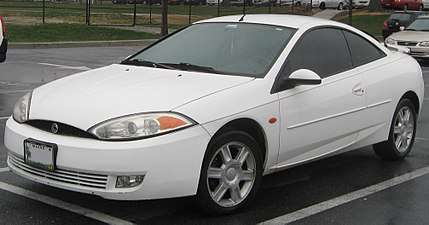 2002 Mercury Cougar
2002 Mercury Cougar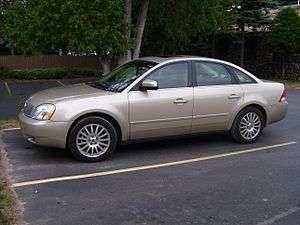 2006 Mercury Montego Premier
2006 Mercury Montego Premier- Mercury Milan Premier
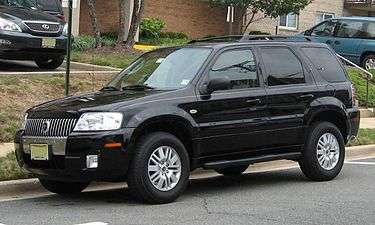 Mercury Mariner
Mercury Mariner 2006-2010 Mercury Mountaineer
2006-2010 Mercury Mountaineer 2007 Mercury Monterey
2007 Mercury Monterey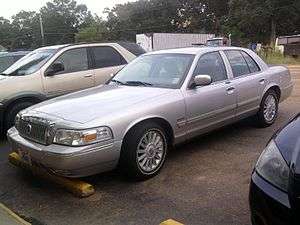 2010 Mercury Grand Marquis
2010 Mercury Grand Marquis
Discontinuation
.jpg)
In 2008, Ford introduced an advertising campaign starring actress Jill Wagner that focused exclusively on attracting female drivers to the Mercury brand in hopes of making it more profitable (this stood in stark contrast to "The Man's Car" ad slogan from the late 1960s)[14][15][16] The campaign was a failure, narrowing the brand image and buyer appeal of the division even deeper, and sales continued to fall. Although the revival of the Mercury Sable nameplate was intended for its wider brand recognition from the Montego, the Sable became the slowest-selling Mercury, with sales falling by nearly half over its predecessor.
On June 2, 2010, Ford announced the closure of the Mercury line by the end of the year. In terms of overall sales in North America, the Mercury brand held a 1 percent share (compared to the 16 percent share of Ford). With under 95,000 vehicles per year sold for 2009, Mercury had sold fewer vehicles than either Plymouth (in 2000) or Oldsmobile (in 2004).[17]
Following the 2009 discontinuation of the Sable, 2010 marked the final model year of the Mountaineer, as the two vehicles completed their model cycles. For a shortened 2011 model year, Mercury sold the Mariner, Milan, and Grand Marquis, with the final Mercury vehicle being a Grand Marquis. For 2010, 93,165 Mercury vehicles were sold, nearly 265,000 fewer than in 2000.[18]
As Ford announced the closure of the Mercury brand, signage related to the brand began to disappear from Lincoln-Mercury dealers. To reflect the change completely, in December 2012, the Lincoln division was renamed the Lincoln Motor Company (its name before World War II).
Sales figures
| Year | 2000 | 2001[19] | 2002[20] | 2003 | 2004[21] | 2005 | 2006[22] | 2007 | 2008[23] | 2009[24] | 2010[25] | Total sales (2000–2010) |
|---|---|---|---|---|---|---|---|---|---|---|---|---|
| Grand Marquis | 122,572 | 112,034 | 80,271 | 79,147 | 76,116 | 64,716 | 54,688 | 50,664 | 29,766 | 24,783 | 28,543 | 723,300 |
| Milan | 5,321 | 35,853 | 37,244 | 31,393 | 27,403 | 28,912 | 166,126 | |||||
| Mariner | 7,171 | 34,099 | 33,941 | 34,844 | 32,306 | 28,688 | 29,912 | 200,961 | ||||
| Mountaineer | 46,547 | 45,574 | 48,144 | 49,692 | 43,916 | 32,491 | 29,567 | 23,849 | 10,596 | 5,169 | 5,791 | 341,336 |
| Montego | 2,974 | 27,007 | 22,332 | 10,755 | 63,068 | |||||||
| Sable | 103,030 | 102,646 | 98,998 | 61,342 | 42,737 | 24,149 | 10,366 | 16,187 | 6,256 | 37 | 465,748 | |
| Marauder | 7,839 | 3,213 | 11,052 | |||||||||
| Mystique | 16,208 | 16,208 | ||||||||||
| Cougar | 40,343 | 29,487 | 19,345 | 2,024 | 91,199 | |||||||
| Villager | 30,443 | 22,046 | 16,442 | 68,931 | ||||||||
| Monterey | 2,213 | 17,407 | 8,166 | 4,467 | 700 | 32,953 | ||||||
| Total Mercury Division sales | 359,143 | 311,787 | 263,200 | 202,257 | 193,534 | 195,949 | 180,848 | 168,422 | 120,248 | 92,299 | 93,195 | Total sales (2000–2010) 2,180,882 |
Mercury in Canada
During the middle of the 20th century, the small dealership network of Ford Motor Company in Canada necessitated some branding changes to attract buyers into showrooms. This was especially the case in smaller, rural communities in need of trucks, as these areas were served by either a Ford or a Lincoln-Mercury dealer, but rarely both.
Monarch
.jpg)
From 1946 to 1957, Ford of Canada marketed the Monarch brand in their own showrooms to attract mid-price customers. The Monarch line used much of the body and trim of the Mercury line in a three-car lineup (Richelieu, Lucerne and Sceptre). The Monarch brand was dropped for 1958 and replaced by the Edsel; poor Canadian sales of the Edsel led to the revival of Monarch for 1959. The introduction of the Ford Galaxie led to brand overlap, leading for Monarch to be discontinued for good in 1961.
In 1975, the Monarch nameplate would return as part of the Mercury lineup (in both the United States and Canada) as the clone of the Ford Granada.
Meteor
.jpg)
In 1949, Mercury of Canada introduced the Meteor brand in an effort to expand into lower-price markets (most closely against Pontiac). As the Mercury of the time was largely a Lincoln body with a Ford powertrain, the Meteor offered a lower price by combining the Ford Custom body with Mercury grille and trim. During the 1950s, this arrangement continued, expanding into a multiple-model line (Niagara, Rideau, and Montcalm). For 1962 and 1963, the brand was dropped, as Mercury adopted the name for its new intermediate-size line. For 1964, the brand was revived, taking the place of the Mercury Monterey in Canada. Again a line of Mercury-trimmed Fords, Meteor was gradually phased into the Mercury lineup starting in 1968. After 1976, the Rideau and Montcalm were discontinued; replaced by a Meteor trim level at the base of the Canadian Mercury Marquis line. Marquis Meteors were dropped after the 1981 model year.
Trucks
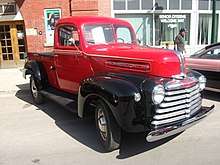
In an effort to increase the availability of its truck lineup, Ford offered rebadged trucks in its Mercury dealerships starting in 1946. While initially applied to the Ford F-Series light trucks (becoming the M-Series), Mercury offered many counterparts of the Ford truck line. Other products included medium-duty conventional trucks, MB-Series school bus chassis, and its own versions of the Econoline van/pickup and the C-Series COE truck.
Early versions of the M-Series often came with a higher output (CM-1 designated) Mercury/Ford Flathead V8 engine over and above the unique Mercury-specific grille, badging and trim that adorned every Mercury M-Series truck.
After 1968, Ford discontinued production of Mercury trucks; the Mercury version of the C-Series cabover ended production in 1972. With the discontinuation of the M-Series and Mercury Econoline, Mercury would not again sell a light truck until the 1993 Villager minivan.
Brand identity
Logo
The first logo of the Mercury brand was its namesake, the Roman god Mercury. Towards the early years of the brand, Mercury used its Roman namesake in a silhouette profile (with signature bowl hat with wings, as shown in the image). This logo was briefly revived for 2003-2004, used in the alloy wheel centers of the Mercury Marauder.
In the mid-1950s, Mercury the logo became a simple "M" with horizontal bars extending outward from the bottom of its vertical elements in each direction.[26] This was described in advertising as "The Big M", and it was well known as the prime sponsor of The Ed Sullivan Show in the late 1950s. After 1959, the "Big M" disappeared, in favor of a crest emblem.
In various forms, Mercury would use a crest emblem on its vehicles through the end of the 1980s. While upper-trim models (such as the Grand Monarch Ghia or Marquis) would feature a crest on the hood or grille emblem, lower-trim models (such as the Monterey or Montego) featured a crest in places such as the wheels. For a time, the Marquis (later Grand Marquis) used a modified version of the Lincoln star emblem.
Following the introduction of the Mercury Cougar, the branding of Mercury vehicles changed, with the Cougar adopting a "prowling cat" logo, similar to the Ford Mustang pony emblem. During the 1970s, the Cougar became the most popular Mercury vehicle, with Mercury launching a "Sign of the Cat" advertising campaign. With the introduction of the 1977 Mercury Cougar, the "prowling cat" logo was changed to a "cat head" logo which was later adapted by the Mercury Lynx and the Mercury Capri.
In 1984, Mercury introduced what would become its final brand emblem (pictured in article information box). Centered in the grille, the silver Mercury emblem is a set of three stacked obtuse angles (also in silver). Introduced with the Mercury Topaz, the emblem was adopted by the Lynx and Sable, with the Grand Marquis/Colony Park adopting it in 1988 (on hood ornaments and wheels). In 1999, the emblem saw a minor revision, with the word "Mercury" added to the top half of the emblem.
For 2005, Mercury became the final U.S. brand to design a new hood ornament, as an option for the Grand Marquis; the hood ornament option lasted for a single year.
- Various Mercury brand emblems, 1939-2011
- hood ornament, 1947 Mercury
- hood ornament, 1951 Mercury Eight
- trunklid badge, 1951 Mercury
 "Mercury Head" emblem (1965 Mercury Comet Caliente)
"Mercury Head" emblem (1965 Mercury Comet Caliente).jpg) 1960s Mercury script (on 1967–1969 Cougar)
1960s Mercury script (on 1967–1969 Cougar).jpg) 1977–1979 Mercury Cougar XR-7 "cat head" hood ornament
1977–1979 Mercury Cougar XR-7 "cat head" hood ornament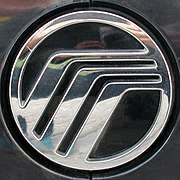 1980s-early 2000s Mercury emblem (1992–1994 Grand Marquis trunklid)
1980s-early 2000s Mercury emblem (1992–1994 Grand Marquis trunklid) Final Mercury emblem (2000–2005 Sable grille)
Final Mercury emblem (2000–2005 Sable grille)
Grille design
The Mercury styling of the brand is most commonly associated with a waterfall-style grille. First making an appearance in the 1946 Mercury Eight, the design was revived in the 1961-1964 Monterey/Colony Park. The design would reappear in the debut of the Mercury Cougar, as designers sought to differentiate the model from the Ford Mustang. During the 1970s, the vertical waterfall grille design was adapted by nearly all Mercury vehicles (with the exception of the Capri and Comet).
In 1986, as part of the introduction of the Mercury Sable and a revision of the Mercury Topaz, the division introduced a "lightbar" front grille. Using low-power light-bulbs, the grille between the headlights was illuminated. By 1992, the feature was adapted by all Mercury vehicles (with the exception of the Cougar and Grand Marquis).
In 1997, as part of the introduction of the Mercury Mountaineer SUV, Mercury reintroduced the chrome vertical "waterfall" grille. In place of the radiator-style grille of Lincoln, several grille shapes were initially used, before the division adapted a rectangular grille opening in the mid-2000s.
"Breezeway" roof
In 1957, Mercury introduced the Mercury Turnpike Cruiser, featuring a roofline with a retractable rear window. From 1958 to 1960, the feature made its return on the Continental Mark-series line, with a reverse-slant rear window (on both hardtops and convertibles). For 1963, Mercury reintroduced the feature as an option for the Monterey; to streamline production, elements of the window design were shared with Ford station wagons. From 1963 to 1966, the optional reverse-slant roofline with retracting rear window was unique to Mercury, featured by no other American brand.
Branding
Following the replacement of the Mercury Eight by the Mercury Monterey in 1952, the division would begin to adapt a nomenclature for its model lines. At various times, the later Montclair, Medalist, Meteor, Montego, (Grand) Marquis, Monarch, Mystique, Mountaineer, Milan, and Mariner all used nameplates starting with "M". Beginning with the debut of the Mercury Cougar, the Mercury Bobcat and Mercury Lynx also used the name of big cats. In line with the Ford use of the Squire name for woodgrained station wagons, Mercury used the Villager nameplate. A name initially used by Edsel, Villager-trim wagons were available in all model lines with the exception of the Colony Park. After becoming dormant in the early 1980s, the Villager name returned for 1993 as the Mercury Villager minivan.
Over time, the Mercury division had used various trim level nameplates on its models. Some of these included GS, LS, Premier, XR (e.g., XR3 and XR7) and Ultimate.
See also
References
- ↑ "'It's time:' Ford to close Mercury by year's end". USATODAY.com. January 6, 2010. Retrieved 2010-06-02.
- ↑ Maynard, Micheline (June 2, 2010). "Ford Appears Ready to End Its Mercury Brand". New York Times com. Retrieved 2010-06-02.
- ↑ "Last Mercury rolls off the line as Mercury rolls into history". AutoWeek.com. January 4, 2011. Retrieved 2011-01-04.
- ↑ trademarKing.in. "Mercury by Ford Motor Company". trademarKing.in. Retrieved 2016-12-27.
- ↑ Special-Interest Autos: 19. July–August 1974. Missing or empty
|title=(help) - ↑ Daniel Vaughan. "1941 Mercury Model 19A news, pictures, and information". Conceptcarz. Retrieved December 2, 2012.
- ↑ Durbin, Dee-Ann; Krisher, Tom (June 2, 2010). "Mercury falling: Ford eliminates mid-range brand". Associated Press. Retrieved August 11, 2017.
- ↑ "The Inflation Calculator". Westegg.com. Retrieved 2017-10-16.
- ↑ http://oldcarbrochures.org/index.php/New-Brochures---May/1951-Mercury-Foldout/1951-Mercury-Foldout-03
- ↑ Canada Buys Taiwan Tracers Archived December 19, 2013, at the Wayback Machine., Taiwan Info, July 14, 1986
- ↑ Allmusic biography
- ↑ http://forum.woodenboat.com/showthread.php?30546-Car-Buyers-Average-Age-by-Make-Model
- ↑ "Archived copy". Archived from the original on May 26, 2013. Retrieved April 7, 2013.
- ↑ http://clickamericana.com/eras/1960s/mercury-the-mans-car-1966
- ↑ http://blog.hemmings.com/index.php/2012/07/05/mercury-the-mans-car-1967/
- ↑ http://auto.howstuffworks.com/1968-mercury-park-lane.htm
- ↑ Raja, Siddharth (September 3, 2007). "Mercury ever closer to getting the axe". Autoblog.com. Retrieved 2009-12-04.
- ↑ "Archived copy" (PDF). Archived from the original (PDF) on January 24, 2011. Retrieved 2011-01-04.
- ↑ "Ford Motor Company's December 2001 U.S. Sales Rise 2.0 % Compared With Year Ago" (Press release). January 3, 2002. Archived from the original on July 10, 2012.
- ↑ "Ford's F-Series Truck Caps 22nd Year in a Row as America's Best-Selling Vehicle With a December Sales Record". Theautochannel.com. November 17, 2004. Retrieved 2009-04-28.
- ↑ "Ford achieves first car sales increase since 1999". Theautochannel.com. January 4, 2006. Retrieved 2009-04-28.
- ↑ "Ford Motor Company 2007 sales". January 3, 2008. Archived from the original on February 12, 2009.
- ↑ "F-Series drives ford to higher market share for third consecutive month" (PDF). Ford Motor Company. January 5, 2009. Archived from the original (PDF) on February 6, 2009. Retrieved 2009-05-14.
- ↑ "Archived copy". Archived from the original on August 26, 2010. Retrieved 2010-12-24.
- ↑ "Archived copy" (PDF). Archived from the original (PDF) on January 24, 2011. Retrieved 2011-01-04.
- ↑ "1956 Mercury Montclair Sport Hardtop Coupe photo – Ken Leonard photos at". Pbase.com. Retrieved 2009-12-04.
External links
| Wikimedia Commons has media related to Mercury vehicles. |
Mercury passenger vehicle timeline, 1940–1979 — next » | ||||||||||||||||||||||||||||||||||||||||||||||||||
|---|---|---|---|---|---|---|---|---|---|---|---|---|---|---|---|---|---|---|---|---|---|---|---|---|---|---|---|---|---|---|---|---|---|---|---|---|---|---|---|---|---|---|---|---|---|---|---|---|---|---|
| Type | 1940s | 1950s | 1960s | 1970s | ||||||||||||||||||||||||||||||||||||||||||||||
| 0 | 1 | 2 | 3 | 4 | 5 | 6 | 7 | 8 | 9 | 0 | 1 | 2 | 3 | 4 | 5 | 6 | 7 | 8 | 9 | 0 | 1 | 2 | 3 | 4 | 5 | 6 | 7 | 8 | 9 | 0 | 1 | 2 | 3 | 4 | 5 | 6 | 7 | 8 | 9 | |||||||||||
| Subcompact | WWII | Bobcat | ||||||||||||||||||||||||||||||||||||||||||||||||
| Compact | Comet | Comet | Comet | Zephyr | ||||||||||||||||||||||||||||||||||||||||||||||
| Monarch | ||||||||||||||||||||||||||||||||||||||||||||||||||
| Mid-size | Montego | Montego | Cougar | |||||||||||||||||||||||||||||||||||||||||||||||
| Meteor | Comet | Comet | ||||||||||||||||||||||||||||||||||||||||||||||||
| Full-size | Custom | Medalist | Meteor | |||||||||||||||||||||||||||||||||||||||||||||||
| Eight | Eight | Eight | Eight | Monterey | Monterey | Monterey | Monterey | Monterey | Monterey | Monterey | ||||||||||||||||||||||||||||||||||||||||
| Montclair | Montclair | Montclair | Montclair | Montclair | Monterey Custom | |||||||||||||||||||||||||||||||||||||||||||||
| Park Lane | Park Lane | Park Lane | Park Lane | Marquis | Marquis | |||||||||||||||||||||||||||||||||||||||||||||
| Turnpike Cruiser | S-55 | S-55 | Marauder | |||||||||||||||||||||||||||||||||||||||||||||||
| Station wagon | Commuter | Commuter | Commuter | Commuter | Commuter | |||||||||||||||||||||||||||||||||||||||||||||
| Voyager | ||||||||||||||||||||||||||||||||||||||||||||||||||
| Colony Park | Colony Park | Colony Park | Colony Park | Colony Park | Colony Park | |||||||||||||||||||||||||||||||||||||||||||||
| Sports car | Capri | Capri II | Capri | |||||||||||||||||||||||||||||||||||||||||||||||
| Cougar | Cougar | |||||||||||||||||||||||||||||||||||||||||||||||||
| Personal luxury | Cougar | Cougar | ||||||||||||||||||||||||||||||||||||||||||||||||
| Pickup truck | M-Series | M-Series | M-Series | M-Series | ||||||||||||||||||||||||||||||||||||||||||||||
« previous — Mercury passenger vehicle timeline, 1980–2011 | |||||||||||||||||||||||||||||||||
|---|---|---|---|---|---|---|---|---|---|---|---|---|---|---|---|---|---|---|---|---|---|---|---|---|---|---|---|---|---|---|---|---|---|
| Type | 1980s | 1990s | 2000s | 2010s | |||||||||||||||||||||||||||||
| 0 | 1 | 2 | 3 | 4 | 5 | 6 | 7 | 8 | 9 | 0 | 1 | 2 | 3 | 4 | 5 | 6 | 7 | 8 | 9 | 0 | 1 | 2 | 3 | 4 | 5 | 6 | 7 | 8 | 9 | 0 | 1 | ||
| Coupe | Sport compact | Capri | Capri | Cougar | |||||||||||||||||||||||||||||
| LN7 | |||||||||||||||||||||||||||||||||
| Personal luxury | Cougar | Cougar | Cougar | ||||||||||||||||||||||||||||||
| Sedan | Subcompact | Bobcat | Lynx | Tracer | |||||||||||||||||||||||||||||
| Compact | Tracer | Tracer | |||||||||||||||||||||||||||||||
| Zephyr | Topaz | Topaz | Mystique | ||||||||||||||||||||||||||||||
| Monarch | |||||||||||||||||||||||||||||||||
| Mid-size | Cougar | Marquis | Sable | Sable | Sable | Sable | Milan | ||||||||||||||||||||||||||
| Full-size | Marquis | Marauder | Montego / Sable | ||||||||||||||||||||||||||||||
| Grand Marquis | Grand Marquis | Grand Marquis | Grand Marquis | ||||||||||||||||||||||||||||||
| Station Wagon | Subcompact | Bobcat | Lynx | Tracer | |||||||||||||||||||||||||||||
| Compact | Zephyr | Tracer | Tracer | ||||||||||||||||||||||||||||||
| Mid-size | Cougar | Marquis | Sable | Sable | Sable | Sable | |||||||||||||||||||||||||||
| Full-size | Colony Park | ||||||||||||||||||||||||||||||||
| Light truck | SUV | Mariner | Mariner | ||||||||||||||||||||||||||||||
| Mountaineer | Mountaineer | Mountaineer | |||||||||||||||||||||||||||||||
| Minivan | Villager | Villager | Monterey | ||||||||||||||||||||||||||||||